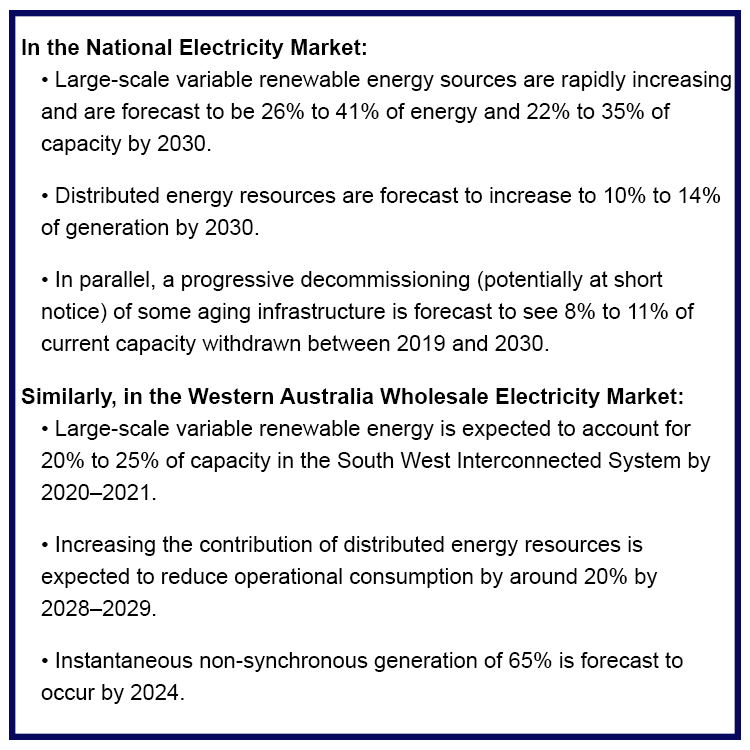Australia’s energy system is transforming at a pace and magnitude not previously seen or imagined. The disruption facing power systems across the globe is accelerated in Australia, as an electrically islanded nation. Indeed, by many metrics, change is happening faster in Australia than in almost all other developed economies, and it’s occurring in a physical and operating environment that poses greater technical and design challenges.

Audrey Zibelman
The impact of the energy sector transformation, manifested in the past five years, is driven by three fast-moving areas:
- Decentralisation, as the power grid increasingly utilises distributed energy resources, driven by pro-active consumers, and small-scale, modular low-cost generators
- Decarbonisation of energy supply, through maturity of renewable energy, energy efficiency technologies, and the potential for a hydrogen economy
- Digitalisation, through innovations in control software, data management, communication speeds, and artificial intelligence
Decentralisation
Much of Australia’s large-scale generation fleet built from the 1950s is reaching its end of technical life and is scheduled for retirement. This, along with a profound change in public expectations for renewable energy as well as its relative low cost and speed of development, has brought a proliferation of large-scale solar and wind generation scattered throughout the National Electricity Market.
Concurrently, Australia leads the world on a per-capita basis in rooftop solar photovoltaic penetration at greater than 20%, with more than two million systems and an average of 6.5 solar panels installed every minute. Penetration rates are already as high as 50% in some parts of the distribution networks in South Australia and Queensland. Despite the growing number of connections and increased reliance on electricity, growth in electricity consumption has been in decline. Energy efficient buildings and appliances, along with the continued growth in the uptake of solar PV systems, are together contributing to record low electricity consumption and demand required from the grid. A continuation of this trend will exacerbate the real-time operation and balancing of the system.
The decentralisation of large-scale and residential renewable generation is completely changing our approach to managing the complex and integrated characteristics of the power system to deliver a secure, low-cost outcome for consumers. For example, while the increase in distributed generation can result in lower consumer costs, it can also result in voltage variability (with reverse power flows from distributed energy devices without visibility not allowing it to be identified and managed), which can in turn degrade power quality and adversely impact machines and home appliances.
In 2018, the Australian Energy Market Operator (AEMO) launched the inaugural Integrated System Plan. The recommended short-term investments, which are being progressed through the regulatory process, are required to maximise the economic use of existing low-cost generation, facilitate the development of new resources, and provide essential system security. The inaugural plan also forecasts transmission system requirements for the National Electricity Market over a 20-year period, based on modelling plausible scenarios and applied technology-neutral analysis to meet future needs.
AEMO is now developing its 2020 Integrated System Plan, which will provide an actionable, whole-of-system roadmap for the efficient development of the National Electricity Market over the next 20 years and beyond. The primary objective of the 2020 plan is to maximise value to end consumers by designing a “least-regret” roadmap for the National Electricity Market, one that meets the cost, security, reliability, and emissions expectations of energy consumers throughout the transition underway across Australia’s energy sector.

Further, AEMO is working with regulators, governments, and market participants to understand, coordinate, and control distributed energy resources to maintain system security, and to unlock its potential to facilitate more affordable electricity supply. The nature and extent of the changes underway in the National Electricity Market means that careful coordination and integration of projects will be crucial to successfully managing a smooth transition—not only for economic objectives, but also to meet the essential technical engineering requirements by which the power system operates.
Decarbonisation
Australia is embracing a pathway to net-zero emissions as new low-emission renewable generation and storage technologies are installed on the transmission networks and in homes and businesses.
AEMO estimates that 61% of coal capacity will close in the National Electricity Market between 2020 and 2040, with solar and wind generation accounting for 75% of future generation projects, hydro and thermal for 20%, and battery storage for 5%. This pipeline of new generation will mean the power system will change more in a technical and operational sense over the next decade than it has in the last century.
Digitalisation
The global explosion in data volumes, new technologies (such as artificial intelligence), and the evolving characteristics of the energy industry are seeing an increased dependence on digitalisation and data across the entire value chain. For AEMO, we’re forecasting an increase in data points on the energy system to increase from 6 per customer in 2010 to more than 100,000 in 2021.
Technology advances are not only enabling consumers and businesses with digital tools and data access to manage their energy resources, but also empowering them to have significant impact on the security of the power system at the macro level. This includes engaging with aggregators who enlist distributed energy resources to coordinate behaviour at scale, including exporting energy, providing demand management, and providing energy services traditionally performed by large-scale generators to improve system security.
The rapid pace of decarbonisation, decentralisation, and digitisation in Australia challenges the ability of existing tools and approaches to build, maintain, and operate a secure, resilient, and sustainable electricity system that minimises electricity prices.
While these changes present multiple challenges, they are also an opportunity for Australia to adapt and demonstrate to the rest of the world how to manage the energy transition successfully.
Audrey Zibelman, CEO
Australian Electricity Market Operator

Thanks for this information Audrey. Congrats on the progress you are making and best wishes in addressing the associated challenges!
Thanks for the info. We follow with interest the experience in Australia, because in our country we are very close to venturing into these challenges. We appreciate the openness and transparency of AEMO showing their experience.
Thank you for sharing this informationenergy trends in australia. It was useful and interesting. You indeed have written it in a layman way so that anyone can understand and work accordingly. You have done a great job.